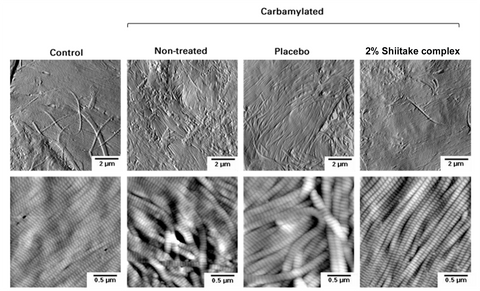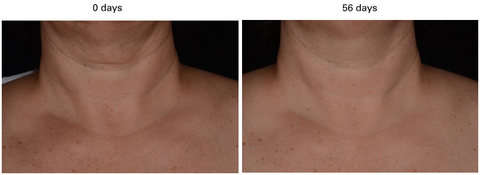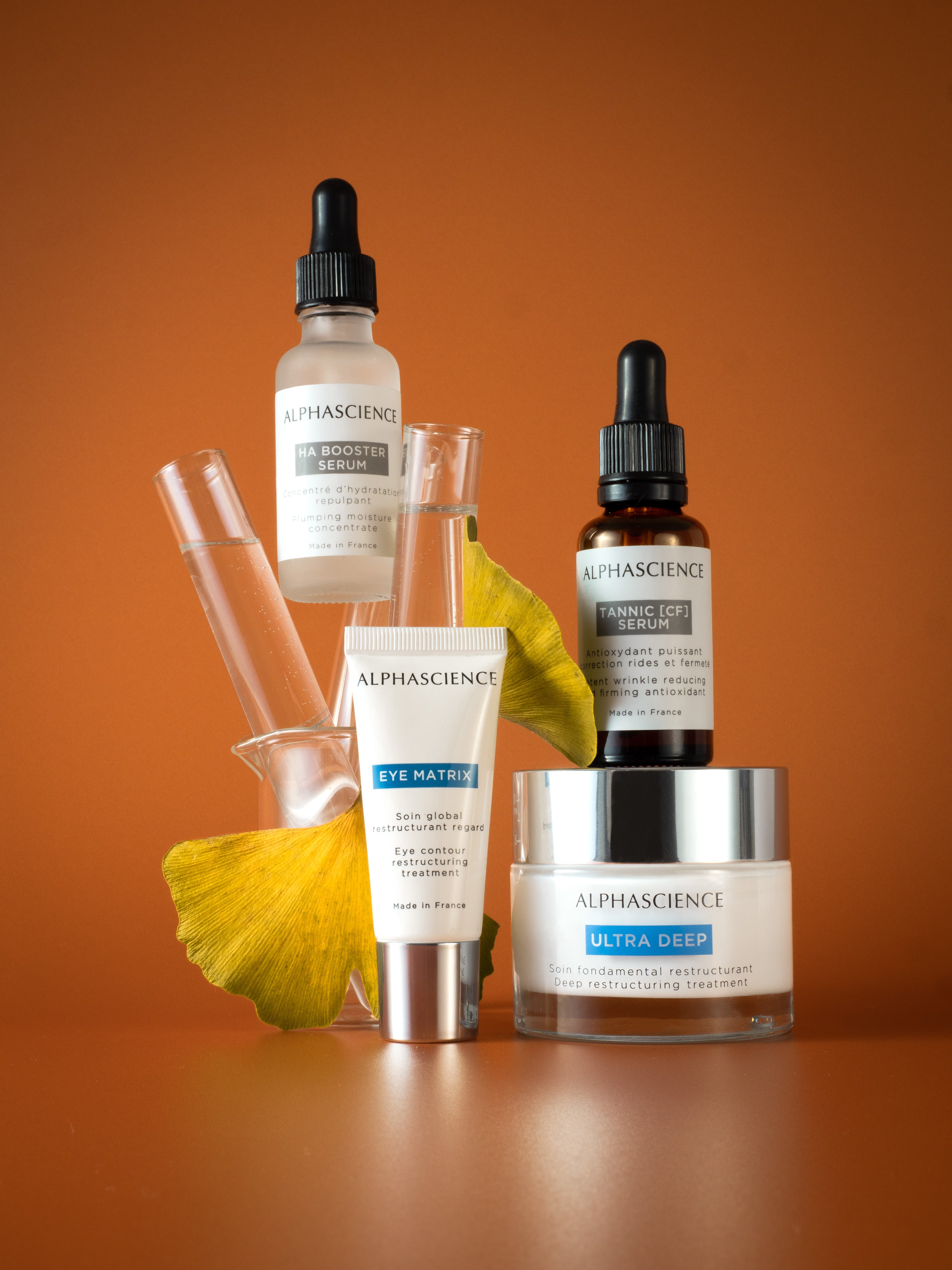ULTRA FIRM : Our new face and neck sculpting concentrate
-
INTRODUCTION
ULTRA FIRM is the first treatment active on collagen carbamylation, beyond glycation. Glycation is a well-known process involved in the process of collagen degradation, Scientists recently discovered that carbamylation, a similar process, has a stronger implication on skin aging due to its even deeper action on collagen destabilization.1
Over time, different hormonal changes occur in the human body, they result in function and in appearance. The variation of oestrogens levels implies inner modifications and changes in the thickness, firmness and look of the skin. Aging results in a deterioration of the quantity and quality of different matrix proteins, such as collagen. The quality of the collagen synthetized is chemically different and there is a reduction in its synthesis: leaving a drier thinner skin, prone to visible wrinkles and firmness and elasticity loss. Areas such as the jawline, neck and décolleté are delicate skin areas that reflect the passage of time. This visible neck area aging, includes horizontal neck lines and wrinkles, sagginess and crepiness.
Repetitive movements due to the use of different devices such as smartphones, may be one of the reasons for premature neck aging, also known as “Tech neck”. Other factors are involved in this process, such as glycation and carbamylation: powerful modifications involved in molecular and skin aging.
ULTRA FIRM is a unique formula for a younger-looking skin, appropriate for daily use and complement for professional treatments. Young skin is characterized by high quality protein, giving the skin a proper firmness and elasticity that is lost with aging.
-
SHIITAKE COMPLEX: ANTI-CARBAMYLATION INNOVATION
Lentinula edodes, commonly known as Shiitake, is a mushroom endemic from Eastern Asia. It’s acknowledged as an elixir of life and has been used by many during history to improve the appearance of the skin, thanks to its antioxidant and anti-aging properties, among others2.
-
Anti-carbamylation innovation
The most important structural proteins are the extracellular matrix proteins (ECM), such as collagen and elastin. Type I collagen in particular is one of the most abundant in the skin matrix and provides tissue structure and strength. Those proteins are especially prone to be carbamylated.
1) Gorisse L. et al. Protein carbamylation is a hallmark of aging. Proc Natl Acad Sci USA. 113(5):1191-6, 2016.
2) Rahman T., Choudhury MBK. Shiitake Mushroom: A tool of Medicine. Bangladesh J. Med Biochem. 5(1):24-32, 2012.
Post-translational modifications (PTM) seem to be a critical step to a proper functionality and quality of collagen. The non-enzymatic post-translational modifications, also known as NEPTMs, have been proved to be implied in the aging process.
One of the most known NEPTM is glycation, which involves the binding of reducing sugars to proteins and resulting in the formation of advanced glycation end (AGE) products, which can interfere with the functioning of collagen 3. After years of research, another NEPTM has been found to affect negatively collagen molecules, carbamylation. Carbamylation, by the reaction of proteins with isocyanic acid, per example with the exposure to pollution, results in the formation of CDPs, carbamylation-derived products, believed to contribute to skin aging and elasticity loss. The accumulation rate of CPDs is inversely correlated with longevity and it’s believed to appear in a more intense and important way than AGEs, suggesting it’s powerful implication on the aging process over glycation4.
Shiitake complex has been proved to effectively reduce protein carbamylation and improve collagen fibrils organisation.
-
EFFICACY TESTS
-
IN VITRO EFFICACY
Results after incubation of Type I collagen with 0.1M potassium cyanate to induce carbamylation, treated with 2% Shiitake complex or left untreated as a control. The levels of carbamylation were determined with a carbamylated bovine serum albumin standard curve and the decrease versus control was calculated.

Figure 1) Carbamylation levels after active treatment vs non-treated carbamylated collagen (****p<0.0001)
⮚ The active treatment reduced carbamylation levels in type I collagen by 75.9% vs. non treated control.
3) Gkogkolou P., Böhm M. Advanced glycation end products. Key players in skin aging? Dermato-Endochrinology, 4(3):259-270, 2012.
4) Jaisson S., Gillery P. Evaluation of Nonenzymatic Posttranslational Modification-Derived Products as Biomarkers of Molecular Aging of Proteins. Clinical Chemistry. 56(9):1401-1412, 2010.
2. EX VIVO EFFICACY
Microscopic images showing collagen fibril bundles. Structural damaged collagen results in a loss of cohesion with more flexible and less aligned fibrils while well preserved collagen forms parallel and straight bundle

Figure 2) AFM images showing collagen microfibril bundles organization at different scales
3. IN VIVO EFFICACY: Firmness evaluation
In order to evaluate the efficacy of the active ingredient, a clinical test was performed during 56 days with a panel of 19 volunteers (41-56 years old), who presented skin sagginess around different areas, such as jawline, under chin, neck and lips.
The numerical evaluation of firmness was performed calculating the maximal deformation (R0) using a cutometer. A decreased in R0 is associated with a firmer skin.
-
Results after 56 days on the face:
 Figure 3) Changes of R0 of the face compared to placebo, after 56 days of treatment (vs initial *p<0.05).
Figure 3) Changes of R0 of the face compared to placebo, after 56 days of treatment (vs initial *p<0.05).
- Results after 56 days on neck and décolleté:
 Figure 4) Changes of R0 of the neck and décolleté after 56 days (vs initial ***p>0.001)
Figure 4) Changes of R0 of the neck and décolleté after 56 days (vs initial ***p>0.001)
- ⮚ A decrease of maximal deformation (R0) was observed, indicating a firmer skin on face, neck and décolleté.
-
MACRO PHOTOGRAPHS
Macro photographs of the volunteers were taken and used to evaluate the firmness and smoothness variations in the skin areas where they applied the active ingredient.

Figure 5) Before and after macro photographs of a subject's neck, after a 8-week treatment with the active treatment.

Figure 6) Before and after macro photographs of the décolleté of a volunteer.

Figure 7) Before and after photographs of the left cheek of a volunteer.
⮚ A firmer and smoother effect was achieved on the face, neck and décolleté after 56 days of treatment.
III. L-GLUTAMINE COMPLEX PEPTIDE
-
Introduction
A sufficient supply of glutamine (NH2-CO-CH2-CH2- CH(NH2) COOH) is important for firm and supple skin. If there is not enough glutamine available; the body takes the necessary proteins from muscle mass and converts it to glutamine and energy. This leads to proteins being lost, muscle strands becoming thinner and the skin becoming generally saggy. This is why glutamine has been referred to as an « internal fountain of youth » by scientists.
-
Collagen synthesis
Naturally present in the human body, glutamine is involved in collagen synthesis in direct stimulation5 and as a precursor of proline and hydroxyproline. Glutamine is also known as an important stimulator of collagen biosynthesis in collagen-producing cells with an excellent bioavailability.
In cultured cells6, scientists found that glutamine is a potent collagen biosynthesis stimulator (it induces an increase in collagen biosynthesis of 400% after 12 hours of incubation).
For the first time, Alphascience, has vectored L-GLUTAMINE as a dipeptide (L-alanyl Glutamine), which acts as a powerful collagen booster to reduce wrinkles and improve skin density, its powerful effect is synergized with Genistein soy isoflavone aglycone.
-
Properties
- Increases nucleotide synthesis.
- Increases protein turn over in muscles by stimulation of proteasomes.
- Anti-glycation effect by stimulation of glycogenesis
- Direct effect on cicatrisation and inflammation
-
GENISTEIN
-
Introduction
Aging involves hormonal changes. Natural oestrogen levels decrease because of age and involves drastic changes on the skin, such as reduction of collagen production and an increased collagen degradation. Those changes lead to deep signs of aging and thinner skin. Isoflavones are polyphenolic compounds that possess both oestrogen
agonist and oestrogen-antagonist properties. For this reason, they are classified as phytoestrogens —plant-derived compounds with estrogenic activity. Isoflavones are the major flavonoids found in legumes. In soybeans, isoflavones are present as glycosides, bound to a sugar molecule. Digestion or fermentation of soybeans or soy products results in the release of the sugar molecule from the isoflavone glycoside, leaving an isoflavone aglycone. One of the most important soy isoflavone aglycones is called Genistein.
5) Bellon G. et al., Glutamine increases collagen gene transcription in cultured human fibroblasts, Acta 1268, 311-323, 1995)
6) Karna E. et al, The potential mechanism for glutamine-induced collagen biosynthesis in cultured human skin fibroblasts, Comparative Biochemistry and Physiology, Part B 130, 23-32 (2001)
-
GENISTEIN in a delivery system, a natural collagen enhancer
ALPHASCIENCE’s Genistein increases fibroblasts’ collagen production, reduces its degradation thanks to its action on metalloproteinase (MP1, MP3) inhibition.
Genistein interferes with the collagen metabolism by boosting its production and preventing its degradation:
Genistein can bind to oestrogen receptors to activate collagen synthesis.
Genistein inhibits tyrosinase kinase, an important element in the activation of activator protein-1 (AP-1), the principal transcription factor involved in the breakdown of collagen. Activation of AP-1 induces the expression of MMPs (matrix metalloproteinases). These enzymes are responsible for the degradation of the extracellular matrix proteins, collagen and elastin, which provide firmness and elasticity to the skin.
In a 3D full skin model, Genistein was shown to increase the biosynthesis of collagen IV using immunolabelling techniques. Collagen IV is essential for the structural integrity and function of the basement membrane (basal stratum).
The immunofluorescent staining of collagen IV and cell nuclei (Hoechst) showed a 53% increase of the collagen IV content in the 3D full skin model treated with genistein. The number of cell nuclei was not increased indicating that Genistein specifically stimulated Collagen IV production
-
Antiglycation properties of Genistein
Genistein is effective against glycation, another Non-enzymatic post-translational modification important for the proper functionality and quality of collagen. Glycation involves the binding of reducing sugars to proteins and results in the formation of advanced glycation end (AGE) products. A high glycemic index and processed food daily intake, seem related to premature aging and firmness loss, consequence of the collagen destabilization.
ULTRA FIRM is a complete and effective treatment that not only stimulates collagen production but also prevents protein degradation and effectively fights glycation, a process directly related to the loss of quality and functionality of collagen itself, both essential for a firm skin.
-
Conclusion
ULTRA FIRM is the first treatment to target collagen carbamylation, in addition to glycation: helping to fight simultaneously multiple factors of aging and specially the firmness loss process.
Carmen.D

![MELA BRIGHT [C+] - SÉRUM 30ml / 1 Fl Oz](http://www.alphascience.com/cdn/shop/files/PACKSHOT-5_165x.png?v=1760454901)



![TANNIC [CF] SERUM 30 ML / 1 Fl. Oz.](http://www.alphascience.com/cdn/shop/files/PACKSHOT_f4332f56-3f9c-438f-8934-9f81e21c380d_165x.png?v=1760452179)


 EUR €
EUR €
 USD
USD
Leave a comment
Please note, comments need to be approved before they are published.